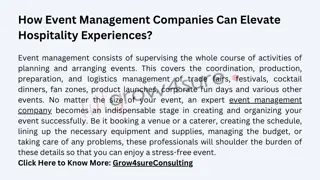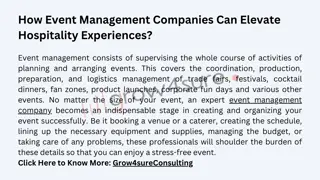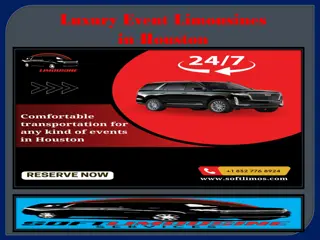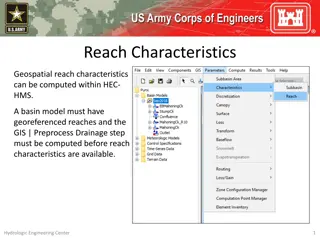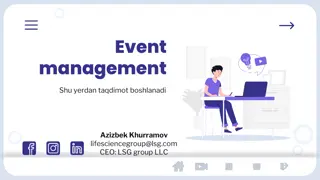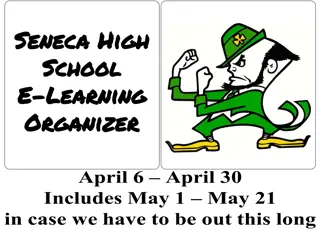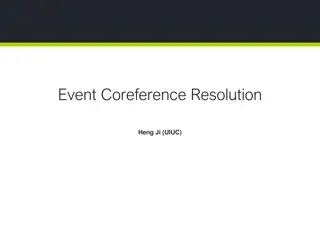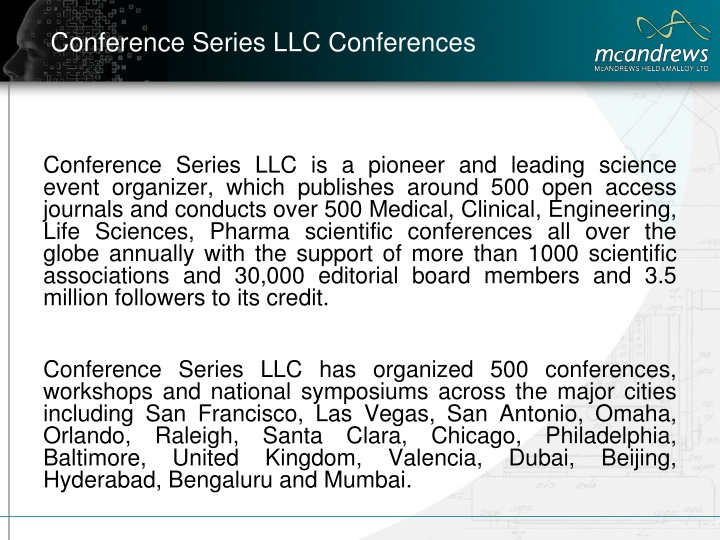
Leading Science Event Organizer with Global Reach
Conference Series LLC is a pioneer in organizing over 500 open access journals and conducting numerous scientific conferences worldwide annually. With a vast network of scientific associations and editorial board members, they have organized events across major cities. Additionally, the content discusses topics such as double patenting, dosing, US biosimilars landscape, and patenting types like statutory and nonstatutory. The overview also touches on the importance of preventing improper extension of exclusionary rights through legal doctrines.
Download Presentation

Please find below an Image/Link to download the presentation.
The content on the website is provided AS IS for your information and personal use only. It may not be sold, licensed, or shared on other websites without obtaining consent from the author. If you encounter any issues during the download, it is possible that the publisher has removed the file from their server.
You are allowed to download the files provided on this website for personal or commercial use, subject to the condition that they are used lawfully. All files are the property of their respective owners.
The content on the website is provided AS IS for your information and personal use only. It may not be sold, licensed, or shared on other websites without obtaining consent from the author.
E N D
Presentation Transcript
Conference Series LLC Conferences Conference Series LLC is a pioneer and leading science event organizer, which publishes around 500 open access journals and conducts over 500 Medical, Clinical, Engineering, Life Sciences, Pharma scientific conferences all over the globe annually with the support of more than 1000 scientific associations and 30,000 editorial board members and 3.5 million followers to its credit. Conference Series LLC has organized 500 conferences, workshops and national symposiums across the major cities including San Francisco, Las Vegas, San Antonio, Omaha, Orlando, Raleigh, Santa Clara, Baltimore, United Kingdom, Hyderabad, Bengaluru and Mumbai. Chicago, Valencia, Philadelphia, Dubai, Beijing,
Double Patenting, Dosing, and the US Biosimilars Landscape Nabeela Rasheed McAndrews, Held & Malloy Ltd., Chicago IL nrasheed@mcandrews-ip.com 2
Where is all the interest coming from? Product Price ($) Price/g ($) Manufacture Cost ($/g) Cost:Price Avastin 687/100mg 6,875 188 2.7% Enbrel 243/25mg 9706 428 4.4% Remicade 784/100mg 7839 188 2.4% Humira 1816/40mg 45400 308 0.7% Rituxan 675/100mg 6751 188 2.8% Herceptin 3331/440 7570 126 1.7% Erbitux 600/100 6000 188 3.1% Soliris 5122/300 17073 135 0.8% AVERAGE 1658 13400 231 2.3% 3
Double Patenting Unique to US Two types of Double Patenting Statutory or same-invention type Nonstatutory or obviousness-type The public should be able to act on the assumption that upon the expiration of the patent it will be free to use not only the invention claimed in the patent but also modifications or variants which would have been obvious to those of ordinary skill in the art . In Re Longi, 759 F.2d 887 (Fed. Cir. 1985) 4
Obviousness-Type Double Patenting Nonstatutory / Obviousness-Type Double Patenting Judicially-created doctrine to prevent improper extension of rights Cannot obtain claims on obvious variations Claim-to-claim comparison one way and two way tests Does any claim in the application define merely an obvious variation of an invention disclosed and claimed in the [other] patent? In Re Vogel, 422 F.2d 438, 441 (CCPA 1970) But applicant can shorten term with terminal disclaimer Even if different inventive entities 5
Policy Two Fundamental Purposes Prevents improper timewise extension of exclusionary rights Law doctrine intended to prevent improper timewise extension of the patent right by prohibiting the issuance of claims in a second patent which are not patentably distinct from the claims of a first patent. In Re Braat, 937 F.2d 589 (Fed. Cir. 1991). Obviousness-type double patenting is a judicially created Prevents harassment by multiple patentees Law The possibility of multiple suits against an infringer by assignees of related patents has long been recognized as one of the concerns behind the doctrine of double patenting. In Re Van Ornum, 686 F.2d 937 (CCPA 1982). 6
Privileged & Confidential 35 U.S.C. 121 Safe Harbor If two or more independent and distinct inventions are claimed in one application, the Director may require the application to be restricted to one of the inventions .A patent issuing on an application with respect to which a requirement for restriction under this section has been made, or on an application filed as a result of such a requirement, shall not be used as a reference either in the Patent and Trademark Office or in the courts against a divisional application or against the original application or any patent issued on either of them, if the divisional application is filed before the issuance of the patent on the other application. 7
Safe Harbor Requires Consonance Gerber Garment v. Lectra Systems (Fed. Cir. 1990) As a result of requires clear demarcation: the line of demarcation between the independent and distinct inventions that prompted the restriction requirement [must] be maintained A divisional application cannot contain claims drawn to the invention set forth in the claims elected and patented in parent application Challenged patent, reference patent and patent in which restriction was imposed cannot claim any of same inventions 8
Terminal Disclaimers Section 253(b) any patentee or applicant may disclaim or dedicate to the public the entire term, or any terminal part of the term, of the patent granted or to be granted Terminal disclaimer may be filed after issuance and even after a finding that the challenged patent is invalid for OTDP. Boehringer Ingelheim v. Barr Labs., 592 F.3d 1340, 1347-1349 (Fed. Cir. 2010) However, TD must be filed before the expiration of earlier-expiring patent Disclaimer is binding upon the patentee and its successors or assignees 9
Later-filed but Earlier Issuing Patent As Reference Gilead Sciences v. Natco Pharma, 753 F.3d 1208 (Fed. Cir. 2014) Invalid for DP A later-issued patent may serve as a DP reference for an earlier-issued patent if later issued patent expires first [I]t is a bedrock principle of our patent system that when a patent expires, the public is free to use not only the same invention claimed in the expired patent but also obvious or patentably indistinct modifications of that invention. TAKEAWAY: It is the comparison of expiration dates that should control, not merely the issuance dates. 10
Later Species Claim not Distinct from Genus AbbVie v. Kennedy Trust, 2014 WL 4100584 (Fed. Cir. 2014) Invalid for DP Even though adjunctively administering was a species of co-administration, it was not patentably distinct over the genus [N]ot every species of a patented genus is separately patentable. [S]pecies are unpatentable when prior art disclosures describe the genus containing those species such that a person of ordinary skill in the art would be able to envision every member of the class .A species contained in a previously patented genus may be patentable if the species manifests unexpected properties or produces unexpected results. 11
Continuations-in-Part Applications Pfizer Inc. v. Teva (Fed. Cir. 2008) 121 explicitly refers to divisional applications That safe harbor, by its literal terms, protects only divisional application[s] (or the original application) and patents issued on such applications. TAKEAWAY: where there is a continuation-in-part application in the chain, the protection of the safe harbor is lost 12
Continuations: Later-filed Genus Claims In Re Goodman, 11 F.3d 1046 (Fed. Cir. 1993) Same rule applies in continuation practice! Original case claimed a method for producing an interferon in a certain type of plant cells Patentee later filed a continuation, broadening claims to cover any plant cell A second application containing a broader claim, more generical in its character than the specific claim in the prior patent typically cannot support an independent valid patent. TAKEAWAY: Terminal disclaimer was needed for later-filed genus claims even for continuation applications 13
Product vs. Process Claims Takeda Pharm. v. Doll, 561 F.3d 1372 (Fed. Cir. 2009) IT DEPENDS [A] product and its process are patentably distinct if the product as claimed can be made by another materially different process. Court rejected reliance on new methods to show patentability [T]he relevant time frame for determining whether a product and process are patentably distinct should be at the filing date of the secondary application. 14
Multiple Assignees In Re Hubbell, 709 F.3d 1140 (Fed. Cir. 2013) Double patenting may exist between a patent and an application/patent filed by: The same inventive entity OR A common assignee / owner OR A different inventive entity having a common inventor Simply put, common ownership or common inventorship is not a requirement for a DP rejection Policy concern with harassment by multiple patent owners Terminal disclaimer not available if no common ownership Newman dissent need common owner / inventor 15
Enbrel: Double Patenting Activity: Enbrel (etanercept) is a Tumor Necrosis Factor (TNF) inhibitor ; it binds to and inhibits TNF to treat autoimmune diseases Structure: Fusion protein having two portions (1) a soluble portion of a human TNF receptor ( TNFR )* Soluble portion of the 75kDa TNFR (i.e., soluble portion of TNFR2) (2) a Fc fragment of a human antibody CH2; CH3 and the hinge region; but not CH1 LPAQVAFTPY APEPGSTCRL REYYDQTAQM CCSKCSPGQH AKVFCTKTSD TVCDSCEDST YTQLWNWVPE LSCGSRCSS DQVETQACTR EQNRICTCRP GWYCALSKQE GCRLCAPLRK CRPGFGVARP GTETSDVVCK PCAPGTFSNT TSSTDICRPH QICNVVAIPG NASMDAVCTS TSPTRSMAPG AVHLPQPVST RSQHTQPTPE PSTAPSTSFL LPMGPSPPAE GSTGDEPKSC DKTHTCPPCP APELLGGPSV FLFPPKPKDT LMISRTPEVT CVVVDVSHED PEVKFNWYVD GVEVHNAKTK PREEQYNSTY RVVSVLTVLH QDWLNGKEYK CKVSNKALPA PIEKTISKAK GQPREPQVYT LPPSREEMTK NQVSLTCLVK GFYPSDIAVE WESNGQPENN YKTTPPVLDS DGSFFLYSKL TVDKSRWQQG NVFSCSVMHE ALHNHYTQKS LSLSPGK * notably, there are two TNFR the 75kDa and the 55kDa receptor; Enbrel utilizes the former 16
Enbrel: Double Patenting 07/580013 Sept. 10, 1990 Abandoned continuation 08/095640 July 21, 1993 5,610,279 6 claims: fusion of 55kd soluble domain + Fc region of human lg heavy chain divisional divisional divisional 08/444791 May 19, 1995 8,163,522 08/444790 May 19, 1995 8,063,182 36 protein claims: soluble fragment of 75kd TNF receptor that comprises SEQ ID NO: 10 + Fc region of human lg heavy chain 08/444793 May 19, 1995 5,808,029 1 claim: polynucleotide which consists of DNA sequence of Fig. 4 (polynucleotide sequence encoding 75kd protein) 10 production related claims: recombinant method of production of fusion of 75kd soluble domain + Fc region of human lg heavy chain Vectors; and polynucleotides 17
Enbrel: Double Patenting US Patent 5,610,279 Filed: July 21, 1993; Issued: March 11, 1997; Expires: March 11, 2014 Included disclosure of 55kDa TNFR (as Fig.1) and a 75kDa TNFR Claims included Generic protein claims to embrace both TNFR species Species claims for each of the two species Fusion protein claims comprising soluble portion of one or other of the two TNFRs Initial restriction requirement: Proteins (Group I); DNA, host cells, and vectors (Group II); and production methods (Group III) Species election requirement: required to elect either 55kDa or 75kDa protein Election: Group I, but with traversal of species restriction Provisionally elected 55 kDa Argument presented: the fact that these species may be separately patentable does not provide basis for restriction because they are separate members of genus covered by generic claim Remainder of prosecution focused on art based rejections in which patentee asserted that the 55 kDa protein was not disclosed Presented two declarations showing alleged unexpected results of the fusion of the soluble fragment of the 55 kDa protein with an immunoglobulin constant region 18
Enbrel: Double Patenting US Patent 8,063,182 Filed: May 19, 1995; Issued: November 22, 2011; Expires: November 22, 2028 Initially filed as a divisional of 279 patent Claims directed only to 55 kDa protein and its fusions with Ig constant regions Prosecuted this subject matter for 10 years 10 years into prosecution: Claims amended to recite both 55 kDa and 75 kDa fusions Immediately resulted in obviousness type double patenting rejection over 279 patent Cancelled/amended claims to remove 55 kDa subject matter Further 5 years of prosecution focusing on 75 kDa fusions: Main point of contention was whether 75kDa was obvious over Wallach [disclosed TNFR from urine; showed broad molecular weight range and only fragment of protein sequence] in view of Capon [disclosed immunoglobulin fusion proteins] Overcame prior art [after appeal to Board] by showing evidence [some based on etanercept studies] showing alleged unexpected results of the fusion protein 19
Enbrel: Double Patenting Double Patenting Analysis of 182 claims using 279 as prior art Claims of 182 patent: Specifically recite protein that comprises a soluble fragment from 75 kDa protein The insoluble TNFR must comprise SEQ ID NO: 10 Claims of 279 patent: Specifically recite protein that comprises a soluble fragment from 55 kDa protein From prior art it can be seen that insoluble 55 kDa protein does not include SEQ ID NO: 10 20
Enbrel: Double Patenting 182 Patent Claim Language Corresponding 279 Patent Claim Language 1. A recombinant protein encoded by a polynucleotide which comprises two DNA subsequences, wherein the first subsequence encodes a soluble fragment of the insoluble TNF receptor protein, wherein said insoluble TNF receptor protein 1. A protein comprising (a) a human tumor necrosis factor (TNF)-binding soluble fragment of an insoluble human TNF receptor, wherein the insoluble human TNF receptor (i) specifically binds human TNF, has a apparent molecular weight of about 55 kilodaltons as determined on a non-reducing SDS-polyacrylamide gel, (ii) has an apparent molecular weight of about 75 kilodaltons on a non-reducing SDS-polyacrylamide gel, and [none] (iii) comprises the amino acid sequence LPAQVAFXPYAPEPGSTC (SEQ ID NO: 10); and and the second subsequence encodes all of the domains of the constant region of a human immunoglobulin heavy chain other than the first domain of said constant region. (b) all of the domains of the constant region of a human immunoglobulin IgG heavy chain other than the first domain of said constant region; wherein said protein specifically binds human TNF. 21
Enbrel: Double Patenting Arguments Against OTDP in 182 claims vis a vis 279 claims PTO determination: 75 kDa species was separately patentable from 55 kDa species Amino acid sequences of the two receptors are different Claims of 182 specifically recite that the receptor be one that includes SEQ ID NO:10; not so in claims of 279 279 claims cannot be construed as including SEQ ID NO: 10 because prior art shows that the sequence of 55 kDa receptor does not include SEQ ID NO: 10 Arguments For OTDP in 182 claims vis a vis 279 claims 182 patent is not a proper divisional application of 279 Initially claimed 55 kDa subject matter with no mention of 75 kDa subject matter If this argument prevails, then safe harbor under 35 USC 121 does not apply During prosecution Applicant tried to obtain examination of 75 kDa protein in same application as 55 kDa Argued that they should be examined as a single invention Made similar arguments in a related patent ( 522) to successfully withdraw restriction requirement 22
Enbrel: Double Patenting Comparison of 182 claims with 029 claims US 5,808,029 contains sole claim: A polynucleotide which consist of DNA sequence of Figure 4 Figure 4 shows DNA sequence of 75 kDa TNFR Subject matter vis a vis original restriction requirement Overall prediction: Amgen should most likely prevail with this type of challenge 182: Group I 029:Group II 182 claims include additional feature of Ig constant region Comparison of 182 claims with 522 claims Subject matter vis a vis original restriction requirement 182 claims are with Group I 522 claims are with Group II and III Comparison would be somewhat moot as 522 expires later than 182 patent 23
Remicade: Double Patenting Activity: Remicade (infliximab) is an antibody that works against TNFa Structure: chimeric mouse/human monoclonal antibody 24
Remicade Double Patenting [blue: current reexamination; yellow: potential] Parent Applications Earliest of which has date of Mar. 18 1991 6,284,471 Restriction Imposed 09/27/1994 Group IV elected Application 08/013,413 Filed: 02/02/93 Abandoned 02/27/94 Application 08/192,093 Filed: 02/04/94 Issued: Sept. 4. 2001 [Group I] CIP CIP CIP CIP 5,919,452 5,656,272 Application 08/192,861 Filed: 02/04/94 [Group IV] Application 08/192,102 Filed: 11/03/11 [Group IV] CIP CIP CIP 5,698,195 6,790,444 Appl. 09/756,301 Filed 01/08/01 Issued: 09/14/04 Application 08/324,799 Filed: 10/18/94 [Group IV] 08/570,674 Filed 12/11/95 DIV DIV DIV 7,070,775 Appl. 10/198,845 Filed 07/18/02 Issued: 07/4/06 6,277,969 09/133,119 Filed 08/12/98 Issued: 08/21/01 CON Restriction Imposed 09/27/1994 Group IV elected 6,835,823 Appl. 09/756,301 Filed 01/08/01 Issued: 09/14/04 CON DIV DIV 7,252,823 Application Filed: 04/06/04 Issued 08/07/07 7,276,239 Appl. 11/314,941 Filed 12/20/05 Issued: 10/02/07 7,373,761 Appl. 11/891,036 Filed 08/08/07 Issued: 05/20/08 CON 25
Remicade: US Patent 6284471 Paten No 6284471 Filed April 2 1994 Issued Sept 4 2001 PTA n/a Terminal Disclaimers None Expiration and comments Sept. 4 2018, but invalid for OTDP July 18 2002 July 4 2006 +773 days 6284471 6790444 (7.11.11) Calculated: April 29, 2013 Actual July .11. 2011 7070775 (Shortened due to TD over 444) Calculated: July 16, 2012 Actual July .11. 2011 Feb. 6. 2002 Aug, 7. 2007 +486 days 6284471 6790444 (7.11.11) 7070775 7276239 7252823 (Shortened due to TD over 444) Dec. 20, 2005 Oct. 2, 2007 +126 days 6284471 6790444 (7.11.11) 7070775 (7.11.11) 7227003 (7.11.11) 7252823 (7.11.11) 6284471 6790444 (7.11.11) 7070775 7252823 7227003 7276239 7179839 6284471 Calculated: July 22, 2011 Actual July .11. 2011 7276239 (Shortened due to TD over 444) Aug. 8. 20017 May 20 2008 0 Mar. 18 2011 7374761 But Exp. Due to non-payment of MF Jan 8 2001 Sept 14 2004 +115 days July 11, 2011 (inc. PTA) (But Exp. Due to non-payment of MF 6790444 26
Remicade: US Patent 6284471 6284471 7070775 7252823 7276239 7374761 6790444 19. An isolated recombinant anti- TNF-a antibody or antigen- binding fragment thereof, said antibody comprising a human IgGi constant region, wherein said antibody or antigen-binding fragment (i) comprises the antigen-binding regions of A2 (ATCC Accession No. PTA- 7045), and (ii) binds to a neutralizing epitope of human TNF-a. in vivo with an affinity of at least 1x108 liter/mole, measured as an association constant (Ka), as determined by Scatchard analysis 9. An isolated recombinant anti-TNF-.alpha. antibody or antigen-binding fragment thereof, said antibody comprising a human constant region, wherein said antibody or antigen-binding fragment (i) comprises the antigen-binding regions of A2 (ATCC Accession No. PTA-7045), and (ii) binds to human TNF- .alpha. with an affinity of at least 1x108 liter/mole, measured as an association constant (Ka). 9. An isolated recombinant anti- TNF-a antibody or antigen- binding fragment thereof, said antibody comprising a human constant region, wherein said antibody or antigen binding fragment competitively inhibits binding of A2 (ATCC Accession No. PTA-7045) to human TNFa. 9. An isolated recombinant anti- TNF.alpha. antibody or antigen- binding fragment thereof, comprising a human constant region, wherein said antibody or antigen-binding fragment comprises A2 (ATCC Accession No.: PTA-7145), and wherein said binding of the antibody or antigen- binding fragment to human TNF- .alpha. inhibits a pathological activity of human TNF-a [note typo in antibody deposit number] 1. The chimeric antibody cA2 A chimeric antibody comprising at least part of a human immunoglobulin constant region and at least part of a non-human immunoglobulin variable region, said antibody capable of binding an epitope specific for human tumor necrosis factor TNFalpha, wherein the non- human immunoglobulin variable region comprises an amino acid sequence selected from the group consisting of SEQ ID NO: 3 and SEQ ID NO: 5. 2. A chimeric antibody comprising at least part of a human IgG1 constant region and at least part of a non- human immunoglobulin variable region, said antibody capable of binding an epitope specific for human TNF-a, wherein the non-human immunoglobulin variable region comprises an amino acid sequence selected from the group consisting of SEQ ID NO: 3 and SEQ ID NO: 5 17. An isolated recombinant anti- TNF-a antibody or antigen- binding fragment thereof, said antibody comprising a human constant region, wherein said antibody or antigen binding fragment comprises the antigen-binding regions of A2 (ATCC Accession No. PTA-7045). 10. An isolated recombinant anti- TNF-a antibody or antigen-binding fragment thereof, comprising a human constant region, wherein said antibody or antigen-binding fragment comprises A2 (ATCC Accession No.: PTA-7145), and which is of immunoglobulin class IgG1, IgG2, IgG3, IgG4, IgM or IgA. 17. An isolated recombinant anti-TNF-.alpha. antibody or antigen-binding fragment thereof, said antibody comprising a human IgG1 constant region, wherein said antibody or antigen-binding fragment (i) comprises the antigen-binding regions of A2 (ATCC Accession No. PTA- 7045), and (ii) binds to human TNF-.alpha. with an affinity of at least 1x108 liter/mole, measured as an association constant (Ka). 7. An isolated recombinant anti- TNF-a antibody or antigen- binding fragment thereof, said antibody comprising a human constant region, wherein said antibody or antigen-binding fragment (i) comprises the antigen-binding regions of A2 (ATCC Accession No. PTA- 7045), and (ii) binds to a neutralizing epitope of human TNF-a in vivo with an affinity of at least 1x108 liter/mole, measured as an association constant (Ka), as determined by Scatchard analysis. 11. An isolated anti-TNF.alpha. antibody or antigen-binding fragment thereof, comprising a human constant region, wherein said antibody or antigen-binding fragment comprises A2 (ATCC Accession No.: PTA-7145), and wherein said anti-TNF-a antibody or antigen-binding fragment thereof is produced recombinantly. 27
Remicade: US Patent 6284471 Only patent with remaining term Claims a chimeric antibody, an immunoassay, and to polypeptides encoding the heavy and the light chains of cA2 (underlying antibody) Ex Parte Reexamination: Parent Applications Earliest of which has date of Mar. 18 1991 Chimeric antibody, immunoassay, polypeptides Application 08/013,413 Filed: 02/02/93 Abandoned 02/27/94 6,284,471 Application 08/192,093 Filed: 02/04/94 Issued: Sept. 4. 2001 [Group I] CIP Crohns CIP 5,656,272 Application 08/192,102 Filed: 11/03/11 [Group IV] RA CIP 5,698,195 CIP Application 08/324,799 Filed: 10/18/94 [Group IV] 28
Remicade: US Patent 6284471 Patentee Arguments: Despite the fact that 471 patent was issued as a CIP of a parent application 08/013,413, PTO should consider it a DIVISIONAL PTO should let Applicant rewrite the specification to be identical to the 413 specification by removing a great deal of information Some success: PTO allowed patentee to amend the specification!! Now Patentee wants to claim safe harbor because claims of 471 are different from those in the reference patents (i.e. composition vs methods of treatment Current Status: On Appeal 29
Remicade: US Patent 6284471 Patent Office Position: reference patents and the challenged patent are CIPs of another parent application ( 413) Hence, even if you can call challenged patent a proper divisional of the parent application, the specification of the reference patent is still a CIP and so still proper rejection. In short there are too many CIPs in the chain they would all have to be changed Likely Outcome of Appeal: Patentee will most likely lose this battle 30
Dosing Many follow-on patents have claims to dosing regimens: Typically filed long after the initial composition of matter and method of treatment patents Usually based on results from clinical testing Inter Partes Review preferred forum for these arguments Typically the arguments are based on obviousness using the publication of composition of matter/method of treatment patents and/or label Key battleground for many biologics 31
LET US MEET AGAIN.. We welcome you to our future conferences of Conference Series LLC through 6th International Conference and Exhibition on Biologics and Biosimilars October 19-21, 2016 Houston, TX, USA http://biosimilars-biologics.pharmaceuticalconferences.com/europe


